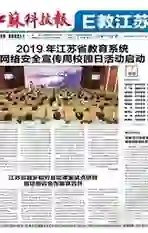【译题】基础教育创新驱动力报告
2019-09-10
SPOTLIGHTING TWO HURDLES
THE GAP BETWEEN TECHNOLOGY AND PEDAGOGY
This hurdle captures with a new sense of urgency a perennial challenge: tensions that arise when the impulse to adopt new technologies takes precedence over preparedness to use them effectively. This challenge encompasses cultural, leadership, pedagogical, curricular and procedural issues. Continuing advances in technology create disconnects between the needs of students and the skill sets of teachers. Technology can accelerate teaching practices—good or bad—and necessitate instructional shifts to effectively support improved student learning.
1.Exploring the Challenge
The gap between technology and pedagogy is multifaceted—and it begins before technology gets to the classroom. From purchasing decisions to planning and implementation, schools sometimes prioritize technology over pedagogy, products over people and potential over reality. The challenge starts at the top, where school system leadership, technology or curriculum departments tend to be the power centers of technology decisions.
School systems can build their capacity to innovate by operating as innovation labs—innovating at a small scale, evaluating the impact with applied research and scaling only after matching 21st century pedagogical methods to the piloted technology.
The pursuit of the “next new thing” in technology can take precedence over teaching and learning. That’s backwards. Defining the knowledge and skills students need to succeed in a digital world, establishing a shared vision of curricular and pedagogical approaches, and developing a strategic plan should precede and then inform technology decisions that prioritize educational value.
2.Imagining the Potential
The gap between technology and pedagogy results in wasted spending, frustrated educators and lost opportunities for students to develop new curiosities and skills for the digital age.
What if we could bridge this gap? Schools could realize higher returns on technology investments with results that matter in education—sound pedagogical practices and opportunities for students to engage in high-value, forward-thinking learning activities. For example, mixed and virtual reality can enhance experiential learning with opportunities to explore and act within and beyond the physical world. With foresight and preparation, educators can move students from passive to active learners who take charge of their own learning, collaborate, participate, inquire, discover, reason and create.
3.Surmounting the Challenge
This hurdle is surmountable. What will it take? Professional development, professional development, professional development. No technology will have the desired impact without professional learning and growth.
But there’s more to it. Education leaders like superintendents, chief technology officers and chief information officers need to understand teacher needs and invite educators to the table for strategic planning. Being part of these conversations can be another aspect of professional development, as educators learn what it means to select and implement technology—and ask questions about costs, support, scalability and sustainability. School systems and schools also might consider an investment in piloting new technologies and sharing the results within a network of schools. Educators also could ask for a seat at the table and work with technology companies to inform research and development of products that truly support effective pedagogy.
4.Additional Resources
The Advisory Board offered other advice:
●Evaluate how technology can contribute to your vision, mission and goals.
●Develop a strategic plan that aligns technology with learning expectations and pedagogy.
●Avoid the “shiny object syndrome” in purchasing technology by bringing cross-cutting expertise, including teachers, to the table.
●Budget for professional development with every technology purchase.
●Champion technology with strong leadership in schools.
●Encourage professional learning communities (PLCs).
●Monitor the effectiveness of technology and make course corrections, if needed.
●Scale and sustain effective technology with an intentional system of multiple, reinforcing, aligned connections to the curriculum, professional development, leadership, assessment and parent engagement.
譯文
聚焦两大核心挑战
挑战一:教育理论与技术实践的差距
这一挑战带来了一种新的紧迫感,它是一项长期挑战:当人们采用新技术的冲动优先于做好有效使用新技术的准备时,紧迫感随之产生。这一挑战包括文化、领导力、教育学、课程和程序等问题。技术的不断进步使学生的需求与教师的技能脱节。技术可以加速好的或坏的教学实践,并且需要教学转变以有效地支持改善学生的学习。
1.探索挑战
技术与教育理论之间的差距是多方面的,这种差距在技术进入课堂之前就开始了。从购买决策到规划和实施,学校有时将技术优先于教学法,产品优先于人,潜力优先于现实。挑战一般始于顶层,学校区域领导、技术或课程部门往往是技术决策的权力中心。
各地区学校可以开办创新实验室来提升创新能力。只有在将21世纪的教学方法与试点技术相匹配后,通过像创新实验室这样的小规模创新,才能评估应用研究和扩展的影响。
一味地追求“新技术”,而不考虑教学和学习,这是一种倒退。学校应先制订战略计划,明确学生在数字世界中取得成功所需的知识和技能,建立课程和教学方法的共同愿景,优先考虑有教育价值的技术决策。
2.激发潜能
技术与教育理论之间的差距,导致教育开支的浪费,使得教育工作者受挫,也让学生失去了为数字时代发展好奇心和新技能的机会。
如果我们能够弥合这一差距,学校可以实现更高的技术投资回报,其结果对教育至关重要——健全的教学实践和高价值、有前瞻性思维学习活动的学生参与机会。例如,混合和虚拟现实可以增强体验式学习,学生有机会在物理世界内外进行探索和活动。通过对混合和虚拟现实技术的远见和准备,教育工作者将学生从被动学习者转变为主动学习者,他们自己负责学习、协作、参与、探究、发现、推理和创造。
3.克服挑战
这个挑战是可以克服的。怎么去克服呢?答案是紧抓专业发展。没有专业的学习和成长,任何技术都不会产生预期的影响。
但除此之外,还有更多因素需要考虑:像主管、首席技术官和首席信息官等教育领导者需要了解教师的需求,并邀请教育工作者参与战略规划;参与对话是专业发展的另一个方面,因为教育工作者需要学会如何选择和实施技术,并询问有关成本、支持、可扩展性和可持续性等问题。学校系统和任一学校也可考虑投资试用新技术并在学校网络内分享结果。教育工作者也可以要求获得席位,并与技术公司合作,为真正支持有效教学产品的研究和开发提供信息。
4.拓展资源
国际咨询委员会提出了其他建议:
●评估技术如何助力实现愿景、使命和目标。
●制订战略计划,力争技术与学习期望和教学方法保持一致。
●在讨论时引入包括教师在内的跨领域专业人才,避免购买技术中的“新奇事物综合征”。
●为教师专业发展的技术购买制订预算方案。
●学校要给予领先性技术强有力的支持。
●鼓励建立专业学习共同体(PLCs)。
●必要时,要监控技术的有效性,并及时修改课程。
●通过将多重强化意向系统与课程、专业发展、领导、评估和家长参与相结合的方式,来维持和推广有效的技术。
